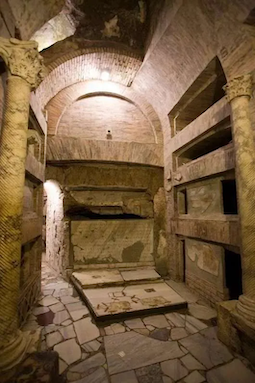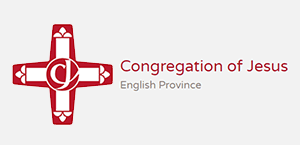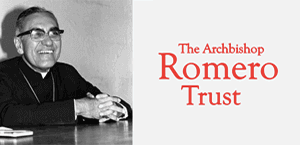Gospel in Art: Memorial of Saint Calistus, Pope Martyr

The Crypt of the Popes, 150-308AD, discovered 1854 by archaeologist Giovanni Battista de Rossi. © Christian Art
Source: Christian Art
Gospel of 14 October 2025
Luke 11:37-41
At that time: While Jesus was speaking, a Pharisee asked him to dine with him, so he went in and reclined at table. The Pharisee was astonished to see that he did not first wash before dinner. And the Lord said to him, 'Now you Pharisees cleanse the outside of the cup and of the dish, but inside you are full of greed and wickedness. You fools! Did not he who made the outside make the inside also? But give as alms those things that are within, and behold, everything is clean for you.'
Reflection on the Catacombs
Pope Saint Callistus I (papacy 218 - 222 AD) was a man whose life shows the astonishing reversals God can bring about. Born a slave in Rome in the late second century, he was condemned at one point to hard labour in the mines of Sardinia. Yet through providence and perseverance, he found his way back to the Christian community and was eventually ordained a deacon by Pope Zephyrinus. In 218 he himself was chosen as Bishop of Rome. From being shackled in the mines, he was raised to shepherd the flock of Christ... a reminder that the Lord often calls those whom the world overlooks.
As pope, Callistus became known for his emphasis on God's mercy. He allowed sinners who had committed very grave faults and sins, to be reconciled with the Church, a stance that caused controversy at the time but revealed the heart of the Gospel. He believed that the Church was not a club for saints, but a community of sinners trying to improve their ways. He thus also started to admit into the Church converts from sects or schisms who had not done penance. Forgiveness alone could welcome them back into the Church. He fought with success the heretics, and established the practice of absolution of all sins, including adultery and murder. He is a key figure in the establishment of the Sacrament of Confession. During a wave of persecution in 222, he was arrested and martyred, thrown into a well.
His names resonates probably most with the Catacombs of Saint Callistus, along the Appian Way in Rome. These catacombs are among the most important early Christian burial places. They date back to the mid-2nd century and became the official cemetery of the Church of Rome. When Callistus was a deacon under Pope Zephyrinus, he was placed in charge of this vast underground complex, which could hold tens of thousands of tombs. Because of his management and later his role as pope, the catacombs took his name. They became the burial site of many early popes. In fact, the famous "Crypt of the Popes" is located there, where nine popes and several martyrs were interred. While the catacombs predate Callistus, his association with them was so strong that they remain linked to his name.
"The Crypt of the Popes', illustrated here, is often called the "little Vatican" of the underground. It served as the official burial chamber for nine 3rd century popes (Popes Pontian (230 - 235), Anterus (235 - 236), Fabian (236 - 250), Lucius I (253 - 254), Stephen I (254 - 257), Sixtus II(257- 258), Dionysius (259 - 268), Felix I (269 - 274), and Eutychian (275 - 283) and several martyrs during the times of persecution. Simple inscriptions, carved in Greek, still mark the resting places of these early successors of Peter. Though the tombs are now empty, the space remains profoundly moving when one visits. During my four year studies in Rome, I went there quite regularly as it was such an awe-inspiring place. The Crypt of the Popes is a reminder that the Church was built not on worldly power, but on the quiet witness of men who gave their lives to shepherd Christ's flock, even unto death. Standing in that dim, narrow chamber, one senses both the fragility of those early centuries and the unshakeable faith of the early Christians that carried the Church through our her early history.
Pope Callistus I was not buried in the Crypt of the Popes in the Catacombs of Saint Callistus, even though the complex is named after him. According to tradition, after his martyrdom in 222 (he was thrown into a well during a local riot in Trastevere), Callistus was buried in the cemetery of Calepodius on the Via Aurelia.
LINKS
Gospel in Art: https://christian.art/
Today's Reflection: https://christian.art/daily-gospel-reading/luke-11-37-41-2025/


















